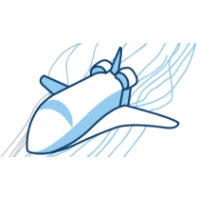Courses by Software
Courses by Semester
Courses by Domain
Tool-focused Courses
Machine learning
POPULAR COURSES
Success Stories
Week-7 Challenge: DC Motor Control
Aim: To study DC Motor Control Objectives: 1. A. Explain a MATLAB demo model named ‘Speed control of a DC motor using BJT H-bridge’. B. Comment on the armature current shoot-up from the scope results. C. Refer to the help section of ‘The Four-Quadrant Chopper DC…
Avinash Dhotre
updated on 23 May 2021
Aim: To study DC Motor Control
Objectives:
1. A. Explain a MATLAB demo model named ‘Speed control of a DC motor using BJT H-bridge’.
B. Comment on the armature current shoot-up from the scope results.
C. Refer to the help section of ‘The Four-Quadrant Chopper DC Drive (DC7) block’. Compare it with the H-bridge model.
2. Develop a 2-quadrant chopper using Simulink & explain the working of the same with the relevant results. (Refer to the article - Multiquadrant operation of the motor )
3. Explain in a brief the operation of the BLDC motor.
Introduction:
Power Semiconductor Devices:
A power electronic converter is an electronic device made of high power semiconductor switches that use different switching states to change the magnitude and waveform of the voltage and current between the input and output.
Power semiconductor devices are widely used in automotive power electronic systems and often dictate these systems' efficiency, cost, and size. Active power semiconductor switches such as MOSFETs and IGBTs serve as load drivers for motors (ranging from 75 kW AC traction motors to 1W DC motors), solenoids, ignition coils, relays, heaters, lamps, and other automotive loads. Diodes are used in automotive systems to rectify AC generated by the alternator, provide a freewheeling current path for IGBTs or MOSFETs in DC/AC inverters and DC/DC converters, and suppress voltage transients. Nowadays, an average vehicle has over 50 actuators, which are often controlled by power MOSFETs or other power semiconductor devices.
Transistor:
It is a semiconductor device that can be used to conduct or insulate electric current or voltage. A transistor basically acts as a switch and an amplifier. In simple words, we can say that a transistor is a miniature device that is used to control or regulate the flow of electronic signals. It is composed of semiconductor material usually with at least three terminals for connection to an external circuit. A voltage or current applied to one pair of the transistor's terminals controls the current through another pair of terminals.
A transistor basically has 3 parts:
- base: Used to activate the transistor
- emitter: This is the positive lead of the transistor
- collector: This is the negative lead of the transistor
Transistors are commonly used in digital circuits as electronic switches, either in an "on" or "off" state, both for high-power applications such as switched-mode power switches and low-power applications such as logic gates.
The common emitter-amplifier is designed so that a small change in the voltage (Vin) changes the small current through the base of the transistor whose current amplification combined with the properties of the circuit means that small swings in Vin produce large changes in Vout.

Based on how they are used, transistors can be classified into:
- BJT( Bipolar junction transistors)
- FET( Field effective Transistor)
Bipolar Junction Transistor:
The three terminals of BJT are base, emitter, and collector. A very small current flowing between base and emitter can control a larger flow of current between the collector and emitter terminal.
BJTs are divided into:
- NPN
- PNP
A bipolar junction transistor is made up of three pieces of silicon. Depending on what is added to the silicon, it will be either N-type or P-type.
An NPN transistor has a piece of P-type silicon (the base) sandwiched between two pieces of N-type (the collector and emitter). In a PNP transistor, the type of the layers is reversed. Below is a typical cross-section of a transistor.
NPN and PNP transistors have very similar schematic symbols. The only difference is the direction of the arrow on the emitter. In a NPN (on the left) it points outward, for a PNP (on the right) it points inward.

We can interpret that arrow in a couple of ways: it's the direction of positive current flow (opposite of electron flow), and also as pointing toward the lower voltage when the transistor is switched on, i.e. for an NPN the emitter has to be at a lower voltage than the base/collector for it to conduct, whereas for a PNP it has to be higher.
Power MOSFET (Metal oxide semiconductor field-effect transistors):
The Power MOSFET is a type of MOSFET. The operating principle of power MOSFET is similar to the general MOSFET. The power MOSFETS are very special to handle the high level of powers. It shows the high switching speed and by comparing it with the normal MOSFET, the power MOSFET will work better. The power MOSFETs is widely used in the n-channel enhancement mode, p-channel enhancement mode, and n-channel depletion mode.
The power MOSFET’s are used in the power supplies
- DC to DC converters
- Low voltage motor controllers.
- These are widely used in low voltage switches which are less than 200V.

IGBT (Insulated Gate Bipolar Transistor):
IGBT is the short form of Insulated Gate Bipolar Transistor. It is a three-terminal semiconductor switching device that can be used for fast switching with high efficiency in many types of electronic devices. These devices are mostly used in amplifiers for switching/processing complex wave patterns with pulse width modulation (PWM).
The IGBT combines the simple gate-drive characteristics of power MOSFETs with the high-current and low-saturation-voltage capability of bipolar transistors. The IGBT combines an isolated-gate FET for the control input and a bipolar power transistor as a switch in a single device. The IGBT is used in medium- to high-power applications like traction motors control and induction heating. Large IGBT modules typically consist of many devices in parallel and can have very high current-handling capabilities in the order of hundreds of amperes with blocking voltages of 6500 V. These IGBTs can control loads of hundreds of kWh.

Power BJT (bipolar junction transistor):
The power bipolar junction transistor (BJT) blocks a high voltage in the off state and high current carrying capacity in the on-state. The power handling capacity is very high. The construction of Power BJT is slightly different from the normal logic transistors as it has an extra highly doped (n) region called a Collector drift region.
The power BJT has three terminals Collector (C), Emitter (E) and Base (B). It has a vertically oriented four-layers structure. The vertical structure uses to increase the cross-sectional area.
There are two types of BJT; n-p-n transistor and p-n-p transistor. Out of these two types, the n-p-n transistors widely use compare to the p-n-p transistor.
Applications-
- Switched Mode Power Supply (SMPS)
- Power Amplifier
- Relay and Drivers
- AC motor speed controller
- DC/AC inverter
- Power control circuit

Comparison:
| PARAMETERS | BJT | MOSFET | IGBT |
| 1. Carriers type | Bipolar device | Majority carrier device | Bipolar device |
| 2. Gate or base drive | Current controlled | Voltage Controlled | Voltage Controlled |
| 3. Temperature coefficient of ON-state resistance | Negative | Positive | Positive |
| 4. Applications | Inverters, Choppers, UPS, SMPS, Induction motor drives. | Choppers, low power UPS. SMPS, brushless DC motor drives. | Inverters, UPS. SMPS, AC motor drives. |
| 5. Switching Power loss | High | Low | Low |
| 6. Input impedance | High | Low | Low |
| 7. On-state voltage drop and Conduction loss | Low | High | Low |
| 8. Parallel operation | Not possible | Possible | Possible |
| 9. Voltage and Current Rating | 1200 V and 800 A | 500 V and 140 A | 1200 V and 500 A |
| 10. Switching Frequency Rating | (10-20) kHz | up to 1 MHz | up to 50 kHz |
H-BRIDGE: An H-bridge is a simple circuit that lets you control a DC motor to go backwards or forward. The load is kept in the centre.

Though the load can in theory be anything you want, by far the most pervasive application if H-bridges is with a brushed DC or bipolar stepper motor (steppers need two H-bridges per motor) load.
Static Operation:
The basic operating mode of an H-bridge is fairly simple: if Q1 and Q4 are turned on, the left lead of the motor will be connected to the power supply, while the right lead is connected to the ground. Current starts flowing through the motor which energizes the motor in (let’s say) the forward direction and the motor shaft starts spinning.

If Q2 and Q3 are turned on, the reverse will happen, the motor gets energized in the reverse direction, and the shaft will start spinning backwards.
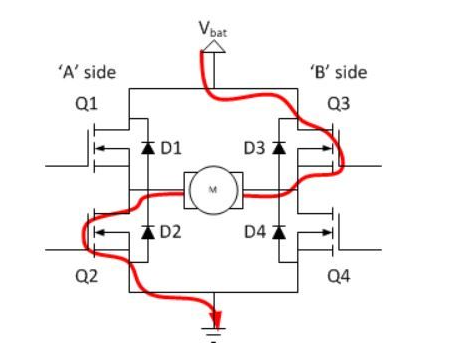
n a bridge, you should never close both Q1 and Q2 (or Q3 and Q4) at the same time. If you did that, you just have created a really low-resistance path between power and GND, effectively short-circuiting your power supply. This condition is called ‘shoot-through and is an almost guaranteed way to quickly destroy your bridge or something else in your circuit.

Q1. A. Explain a MATLAB demo model named ‘Speed control of a DC motor using BJT H-bridge’.

The above Speed control of a DC motor using the BJT H-bridge SIMULINK model is opened in MATLAB by typing "power_Hbridge" in the command window.
Blocks Used
IGBT - The IGBT block implements a semiconductor device controllable by the gate signal. The IGBT is simulated as a series combination of a resistor Ron, inductor Lon, and a DC voltage source Vf in series with a switch controlled by a logical signal (g > 0 or g = 0). The IGBT block contains a series Rs-Cs snubber circuit, which is connected in parallel with the IGBT device (between terminals C and E).
When ON state
When OFF state
The Bipolar Junction Transistor (BJT) when used for power switching applications, operates as an IGBT. When it is conducting (BJT operating in the saturated region), a forward voltage Vf is developed between collector and emitter (in the range of 1 V). Therefore, the IGBT block can be used to model the BJT device.

Diode - The Diode block models a piecewise linear diode. If the voltage across the diode is bigger than the Forward voltage parameter value, then the diode behaves like a linear resistor with low resistance, given by the On resistance parameter value, plus a series voltage source. If the voltage across the diode is less than the forward voltage, then the diode behaves like a linear resistor with low conductance given by the Off conductance parameter value.

DC Machine - The DC Machine block implements a wound-field or permanent magnet DC machine. This block consists of 3 segments- armature circuit, field circuit and a torque input-measurement signals output. The motor used here is 5HP, 240V, 1750 RPM. It simulates a fan type model, proportional to the square of speed. The armature voltage can be varied from 0 to 240V by changing the duty cycle. The duty cycle can be changed by a pulse width generator block.

Here the DC Machine is used as a DC motor. We need to control the DC motor's rotation in such a way that when to spin ACW & when to spin CW and with variable speeds. For that, we use an H-bridge configuration of circuits. The name H-bridge is given as the circuit resembles the letter "H".
This circuit requires switches that can automatically turn ON/OFF very fastly as per the requirements. Hence we use power switches. The switch used is IBJT, but the model is said to have a BJT because BJT works as IGBT as a switch.


| BE | BC | Mode | Operation |
| Reverse | Reverse | Cut off | Switch (Off) |
| Forward | Forward | Forward Active | Amplifier |
| Forward | Forward | Saturation | Switch (On) |
From the above table it is clear that, when the BJT is in saturation or conducting state, the Base-Emitter and Base-Collector is forward bias. Hence the BJT act in ON state. The BJT is controlled by SIMULINK signals as 1 and 0. Logic “1” represents a higher voltage, such as 5 volts, which is commonly referred to as a HIGH value, while a logic “0” represents a low voltage, such as 0 volts or ground, and is commonly referred to as a LOW value. But to make this 5 volts as 1 volt, we have used IGBT block instead of BJT. The H-bridge consists of 4 transistors, namely Q1, Q2, Q3 & Q4. Each one has a snubber circuit connected in parallel.
The H- bridge works in such a way that at a time two IGBT and 2 Diodes are in on state. When the IGBT's Q2 & Q3 are in conducting state and the diodes D1 & D4 act as freewheeling diodes, makes the motor spin in one direction. When the IGBT's Q1 & Q4 are in conducting state and the diodes D2 & D4 act as freewheeling diodes, makes the motor spin in opposite direction. The motor speed can be controlled by the self-excitation voltage provided across the rotor windings (i.e. 0 to 300V).

Case-1:
- Total cycle time = 1 sec
- Duty cycle = 75%
- Forward motoring time = 0.5 sec
- Reverse motoring time = 0.5 sec


when the SIMULINK model is run, the output obtained is as shown -

B. Comment on the armature current shoot-up from the scope results.
In the above plot, the armature current has a sudden rise and drop when the motor changes direction from forward to reverse motion.
A Pulse Width Modulation (PWM) Signal is a method for generating analogue signal using a digital source and a frequency. By cycling a digital signal OFF and ON at a fast enough rate, and with a certain duty cycle, the output will appear to behave like a constant voltage and current analogue signal when providing power to devices.

We can see the first plot of speed, starts from the positive side then runs constantly at that rpm and then suddenly drops and spin in opposite direction. Simultaneously the armature current also spikes up initially at the start and also at the reversal of armature voltage causing the rotor to spin in opposite direction. This happens because, by default, the armature voltage control is set at a step time of t=0.5. It means at t=0.5s the motor rotation will change in the reverse direction as the armature voltage will reverse.
To minimize the sudden surge in the armature current at the start and when the motor runs in reverse, we have to modify the duty cycle. The default value is 75%. This means that the voltage is supplied 75% of the time to the motor and the rest 25%, the motor receives no voltage from the source and it is in an OFF state. This sudden change in OFF and ON state (i.e. reversal of armature voltage) causes the armature current to spike up abruptly.
Case-2:
- Total cycle time = 1 sec
- Duty cycle = 60%
- Forward motoring time = 0.5 sec
- Reverse motoring time = 0.5 sec


When the duty cycle is 60% - there is a sudden spike of armature current.
Case-3:
- Total cycle time = 1 sec
- Duty cycle = 50%
- Forward motoring time = 0.5 sec
- Reverse motoring time = 0.5 sec


When the duty cycle is 50% - there is again a sudden spike in armature current when the armature voltage reverses at t=0.5s. But it is not at the start of the motor.
Case-4:
- Total cycle time = 1 sec
- Duty cycle = 40%
- Forward motoring time = 0.5 sec
- Reverse motoring time = 0.5 sec


When the duty cycle is 40% - the sudden surge in the armature current at the start of the motor and t=0.5s has been reduced. And the armature current is constant at approximately 7A in both +ve and -ve directions.
C. Refer to the help section of ‘The Four-Quadrant Chopper DC Drive (DC7) block’. Compare it with the H-bridge model.
The 'DC7' motor drive in Simscape™ Power Systems™ software, referred to as the four-quadrant chopper DC drive block in MATLAB/Simulink. It represents a four-quadrant, DC-supplied chopper drive for DC motors, featuring closed-loop speed control with the four-quadrant operation. This closed-loop speed control gives the armature current of the machine as an output. By using a PI current controller and adjusting the chopper duty cycle, we get the commanded armature current as per our needs. The duty cycle is then compared with a sawtooth carrier signal to obtain the required PWM signals for the chopper.
Compared to other DC drives that are available, the main advantage of using the four-quadrant chopper DC drive is that it can operate in all 4 quadrants. In each quadrant, its characteristics represent a different mode of operation.
The first quadrant is forward motoring, the second is reverse braking, the third is reverse motoring and the fourth is forward braking. Another advantage is that it comes with a high switching frequency DC-DC converters, resulting in a lower armature current ripple compared to thyristor-based DC drives.
The Simulink block of DC7 and its circuit diagram is given below:


Simulink block of DC7 Circuit diagram
From the help section of Matlab documentation, The DC7 file or the Four-Quadrant Chopper DC drive can be found out and by opening the model file we get the Simulink blocks.
The model is obtained by typing dc7_example in the command window. The model looks like as shown below -

Here the power supply is not dc. It is a 380v 50Hz AC power supply. It means that the rotor of the generator turns 50 cycles per second, the current changes 50 times per second back and forth, direction changes 100 times. That means the 380V changes from positive to negative, and from negative to positive voltage, this process converts 50 times/second.
The model contains AC to DC Converter (i.e Rectifier Bridge + Braking Chopper), Four-Quadrant Chopper DC Drive, bus model subsystem. The applied AC 380V is converted to a 515V DC supply by an AC to DC converter. This converter includes a rectifier and a braking chopper. The braking chopper is used to convert the voltage from the motor while regenerative braking, exceeding a threshold voltage into thermal energy. This is done by the brake resistor connected in series with the diode and a switching device inside the braking chopper. The braking chopper activates when the voltage reaches 560V and it switches OFF when the voltage is 520V. Though the AC source is converted to 515V, we must include losses. Hence the voltage is kept at 520V.
The motor runs based on the speed reference block provided.
Four quadrant operation of DC Motor - A motor operates in two modes – Motoring and Braking. A motor drive capable of operating in both directions of rotation and of producing both motoring and regeneration is called a Four Quadrant variable speed drive. In motoring mode, the machine works as a motor and converts the electrical energy into mechanical energy, supporting its motion. In braking mode, the machine works as a generator and converts mechanical energy into electrical energy and as a result, it opposes the motion. The Motor can work in both, forward and reverse directions.
| Function | Quadrant | Speed | Torque | Power Output |
|---|---|---|---|---|
| Forward Motoring | I | + | + | + |
| Forward Braking | II | + | - | - |
| Reverse Motoring | III | - | - | + |
| Reverse Braking | IV | - | + | - |

Applications of 4 - Quadrant Operation
- Compressor, pump and fan type load requires operation in the I quadrant only. As their operation is unidirectional, they are called one quadrant drive systems.
- Transportation drives require operation in both directions.
- If regeneration is necessary, application in all four quadrants may be required. If not, then the operation is restricted to quadrants I and III, and thus dynamic braking or mechanical braking may be required.
- In hoist drives, a four-quadrant operation is needed.
The Simulink DC7 four-quadrant drive contains a speed and current controller, regulator switch, chopper, dc motor
Speed controller block - The inputs are speed reference and motor speed, and outputs a current reference. This output current reference is in turn used by the current controller block to obtain the electromagnetic torque needed to reach the desired speed.
Regulation Switch block - The Regulation Switch block consists of a DC machine (wound-field type) torque controller model and a Simulink Switch model. The latter is used to select the regulation mode, i.e. torque or speed regulation of the DC drive. The torque controller provides a DC current reference. A second reference DC current is obtained from the speed controller. Depending on the regulation mode, the Simulink switch selects between the two DC current references.
Current controller block - The Current Controller (DC) block models a PI current controller for use with a DC machine. The block has multiple instances, depending on the DC drive type (chopper DC drive or thyristor-based DC drive) and operating quadrants (one-, two-, or four-quadrant). It has two operating modes to represent a detailed or an average-value current controller. The DC current controller block inputs are the current reference (in pu) and the armature current flowing through the motor. The outputs are current reference, duty cycles, PWM pulses, and reference current error. From here the PWM pulses are fed to the chopper block where the switches are present.
Chopper block - The Chopper block models a standard half-bridge (one leg, two IGBTs) or full-bridge (two legs, four IGBTs) converter model. It has two operating modes to represent a detailed or an average-value chopper. Each operating mode has multiple instances depending on the DC motor drive type (two- or four-quadrant operation). The chopper block outputs the desired armature current to the DC motor. To avoid the sudden surge in the current fluctuations, a smoothing inductance is connected in series with the chopper.
DC Machine - Here the motor is coupled to a linear load, which means that the mechanical torque of the load is proportional to the speed.
OUTPUT -

The scope shows the motor armature voltage and current, the four IGBT pulses and the motor speed on the scope. The current and speed references are also shown. The motor is coupled to a linear load, which means that the mechanical torque of the load is proportional to the speed.
Advantages:
- 4 quadrant choppers have more control over the deceleration of the motor and can more accurately brake the motor. This will make the deceleration smoother.
- The second benefit is that it reduces the risk of current spikes, which can damage the motor and the controller itself because this can occur when the motor is made to brake while running at a high speed. So the controller life is generally longer with 4 quadrant choppers, by mitigating those sudden surges or spikes from the output.
- A third advantage is that 4 quadrant choppers are more efficient because lesser energy is wasted as heat and lesser current spikes occur which means lesser power dissipation over a complete.
- In the case of a vehicle, the 4 quadrant chopper makes regenerative braking possible so that when the motor is made to brake, the kinetic energy of the rotor moving is transferred back as electrical energy which can then be used to charge a battery.
Comparison:
|
DC drive using BJT H-bridge |
DC drive using Four-Quadrant Chopper |
|
Power switches are powered by a 240V DC supply. |
Power switches are powered by a 380V 50Hz AC 3-phase supply which is converted to a 515V DC supply. |
|
Field windings are separately excited by a 300V DC supply. |
Field windings are separately excited by a 150V DC supply. |
|
Works only in forward motoring and reverse motoring. |
Here the D motor operates in all 4 quadrant - forward motoring, reverse motoring, forward braking and reverse braking. |
|
It is just controlling the DC motor speed. |
It is a drive that symbolizes the mechanical and power electronics components. |
|
Efficiency is less. |
Efficiency is more because of being a drive. |
|
Here the torque is proportional to the square of the speed. |
Here the motor is subjected to linear load. Hence the torque is just proportional to speed. |
2. Develop a 2-quadrant chopper using Simulink & explain the working of the same with the relevant results. (Refer to an article - Multiquadrant operation of motor )
Circuit Diagram of a 2-quadrant chopper:

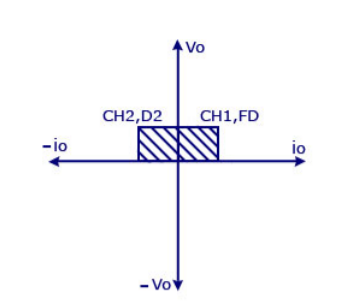
Developed 2-quadrant chopper using Simulink:

Model Construction :
Click on Simulink Browser and open Library to Search for Component required to Build C-Class chopper as follows:
- Power GUI
- Pulse generator
- Current measurement
- Voltage measurement
- Diode
- MOSFET
- Logical operator (NOT)
- Series RLC
- Scope
- Arrange the Blocks as per the circuit connection shown above in the Model.
- Double click on MOSFET and DIODE Block to Disable (uptick show measurement port), and rotate the diode in upward direction as per our requirement (source should be facing in Downward direction for MOSFET and for DIODE source should be in upward direction)
- Open series RLC block and Change the branch type to (L) with default value 1 mill H, once done arrange according to circuit diagram.
- Open logical operator and select NOT in Operation options, connects its Input to output of PULSE Generator block. The reason we use NOT gate to ensure both the Switches does not conduct simultaneously if they do so supply will be short-circuited.
- We will be giving the tapping for the PULSE gate terminal for 1 switch MOSFET1 and from NOT gate we are giving it to other switch MOSFET2. So if MOSFET1 is conducting MOSFET2 will not conduct because we are using the NOT gate.
- Once done we will be measuring the voltage by connecting its 1st port at staring of inductor and other to DC2 supply which is connected adjacent.
- And output is connect to 1st of the 3 port of scope input, current Measurement port is also connected to 2nd port of Scope and 3rd port is taken from output of PULSE Generator.
- Double click on main DC Voltage supply and set amplitude (V) to 24v and for adjacent DC2 supply set amplitude as 12v.
- Open Pulse generator block set amplitude to 10 for better viewing, time period set to 1 sec, pulse width is 50 (because we 50% to be ON and 50% to be OFF) .i.e. NOT gate is ON when 50% OFF
The working of the Model is given below:
Type C chopper is obtained by connecting type –A and type –B choppers in parallel. We will always get a positive output voltage V0 as the freewheeling diode FD is present across the load. When the chopper is on the freewheeling diode starts conducting and the output voltage v0 will be equal to Vs. The direction of the load current i0 will be reversed. The current i0 will be flowing towards the source and it will be positive regardless of the chopper is on or the FD conducts. The load current will be negative if the chopper is or the diode D2 conducts. We can say the chopper and FD operate together as a type-A chopper in the first quadrant. In the second quadrant, the chopper and D2 will operate together as type –B chopper.
The average voltage will be always positive but the average load current might be positive or negative. The power flow may be like the first quadrant operation i.e from source to load or from load to source as the second quadrant operation. The two choppers should not be turned on simultaneously as the combined action may cause a short circuit in supply lines. For regenerative braking and motoring, this type of chopper configuration is used.
Let the voltage of the DC voltage source be 24 volts.

Let us consider an series RLC branch block and select inductor L . Thus block works as a load.
To consider LE load i.e motor load , and dc voltage source of 12 volt is also connected in series with inductor.

The pulse generator block is used to create gate pulse.
The not gate is used in the model so that the two MOSFET will not get closed at the same time otherwise short circuit will occur. Due to use of not gate, when one mosfet is ON the other mosfet will get OFF and when other mosfet is ON the first mosfet will get OFF .
The amplitude of pulse generator is kept 10 so that we can clearly see the pulses at scope and let period be 1 seconds and let pulse width be 50%.

Output:

The voltage waveform is not going less than zero, the minimum value of voltage is zero and maximum value is always in the positive direction.
However in current waveform, the current increases and decreases, current may be positive as well as negative.
The pulse amplitude is 10 thus from pulse waveform we can see that the pulse amplitude is 10.
3. Explain in a brief about operation of BLDC motor.
BLDC Motor: A brushless DC motor (also known as a BLDC motor) is an electronically commuted DC motor that does not have brushes. The controller provides pulses of current to the motor windings that control the synchronous motor's speed and torque.
These types of motors are highly efficient in producing a large amount of torque over a vast speed range. In brushless motors, permanent magnets rotate around a fixed armature and overcome the problem of connecting current to the armature. Commutation with electronics has a large scope of capabilities and flexibility. They are known for smooth operation and holding torque when stationary. In conventional Brushed DC Motors, the brushes are used to transmit the power to the rotor as they turn in a fixed magnetic field. A BLDC motor used electronic commutation and thus eliminates the mechanically torn brushes.
Before explaining the working of a brushless DC motor, it is better to understand the function of a brushed motor. In brushed motors, there are permanent magnets on the outside and a spinning armature that contains an electromagnet inside. These electromagnets create a magnetic field in the armature when the power is switched on and help to rotate the armature.
The brushes change the polarity of the pole to keep the rotation on of the armature. The basic working principle for the brushed DC motor and brushless DC motor is the same i.e. internal shaft position feedback.
A Brushless DC motor has only two basic parts: the rotor and the stator. The rotor is the rotating part and has rotor magnets whereas the stator is the stationary part and contains stator windings. In BLDC permanent magnets are attached to the rotor and move the electromagnets to the stator. The high-power transistors are used to activate electromagnets for the shaft turns. The controller performs power distribution by using a solid-state circuit.
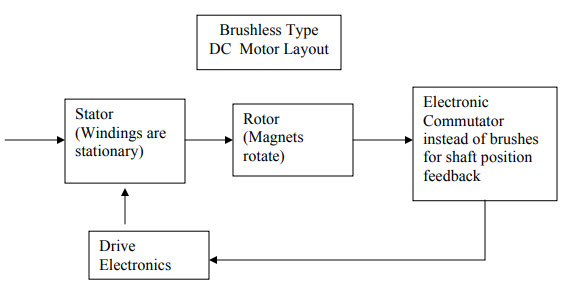
Construction of BLDC motors:
The main design difference between brushed and brushless motors is the replacement of a mechanical commutator with an electric switch circuit. Keeping that in mind, a BLDC motor is a type of synchronous motor in the sense that the magnetic field generated by the stator and the rotor revolve at the same frequency.
Brushless Motors are available in three configurations: single-phase, two-phase, and three-phase. Out of these, the three-phase BLDC is the most common one.
The following image shows the cross-section of a BLDC Motor.

As we can see in the image, a BLDC motor consists of two main parts: a stator and a rotor.
Stator:
The structure of the stator of a BLDC motor is similar to that of an induction motor. It is made up of stacked steel laminations with axially cut slots for winding. The winding in BLDC is slightly different from that of the traditional induction motor.

Generally, most BLDC motors consist of three stator windings that are connected in star or ‘Y’ fashion (without a neutral point). Additionally, based on the coil interconnections, the stator windings are further divided into Trapezoidal and Sinusoidal Motors.
In a trapezoidal motor, both the drive current and the back EMF are in the shape of a trapezoid (sinusoidal shape in case of sinusoidal motors). Usually, 48 V (or less) rated motors are used in automotive and robotics (hybrid cars and robotic arms).
Rotor:
The rotor part of the BLDC Motor is made up of permanent magnets (usually, rare earth alloy magnets like Neodymium (Nd), Samarium Cobalt (SmCo), an alloy of Neodymium, Ferrite, and Boron (NdFeB)).
Based on the application, the number of poles can vary between two and eight with North (N) and South (S) poles placed alternately. The following image shows three different arrangements of the poles. In the first case, the magnets are placed on the outer periphery of the rotor.


The second configuration is called a magnetic-embedded rotor, where rectangular permanent magnets are embedded into the core of the rotor. In the third case, the magnets are inserted into the iron core of the rotor.
Now, some crucial things are a must to have in the case of BLDC motors i.e. its sensors.
The BLDC motor has no Brushes, the commutation is controlled electrically. To rotate the motor, the windings of the stator must be energized in a sequence and the position of the rotor which the North poles and South poles of the rotor must be known to precisely energize a particular set of stator windings.
A Position Sensor, which is usually a Hall Sensor is generally used to detect the position of the rotor and transform it into an electrical signal.
HALL-EFFECT SENSOR:
A Hall-effect sensor (or simply Hall sensor) is a device to measure the magnitude of a magnetic field. Its output voltage is directly proportional to the Magnetic field strength through it. The Hall-sensor is used for, Proximity Sensing, Positioning Sensor, Speed Detection, and Current Sensing.
Most BLDC Motors use three Hall Sensors that are embedded into the stator to sense the rotor’s position. The output of the Hall Sensor will be either Low or High. Depending on whether the North or South pole of the rotor passes near it. By combining the results from the three sensors, the exact sequence of energizing can be determined.
THE WORKING PRINCIPLE OF BLDC MOTOR:
Consider the following setup of three windings in the stator designated A, B, and C. For the sake of understanding, let us replace the rotor with a single magnet. 

- We know that when a current is applied through a coil, a magnetic field is generated and the orientation of the field lines i.e. the poles of the generated magnet will depend on the direction of the current flowing through the coil.
- Now, by supply current to coil A, it will generate a magnetic field and attract the rotor magnet. The position of the rotor magnet will shift slightly clockwise and will align with coil A. similarly for coil B and coil C the magnet rotates in the clockwise direction

- Here, the Three-phase BLDC motor is used and the phases are A, B, &C.
- These phases are connected to an Electronically commutator which is a power electronic controller which acts as an Inverter.
- The Hall sensor is placed between poles to sense the position of the rotor.
- Here three Hall sensors are placed in Stator.
- Each phase signal is combined with High, Low, and OFF.
- The hall signal is taken as the frequency of 0 to 360 degrees.
- When The Hall-1 is OFF to ON, Hall-2 is OFF, and Hall-3 is OFF to ON. So Hall-1 and Hall-3 are present.
- Then phase A is in the OFF signal, phase B is OFF to High, and phase C is Low.
- Similarly, in three phases if one phase is of the other two phases are acts as positive and negative.
To understand it more easily a gif of the same above circuit is given below:

Advantages of BLDC Motor:
- Brushless motors are more efficient as their velocity is determined by the frequency at which current is supplied, not the voltage.
- As brushes are absent, the mechanical energy loss due to friction is less which enhanced efficiency.
- BLDC motor can operate at high speed under any condition.
- There is no sparking and much less noise during operation.
- More electromagnets could be used on the stator for more precise control.
- BLDC motors accelerate and decelerate easily as they are having low rotor inertia.
- It is a high-performance motor that provides large torque per cubic inch over a vast speed range.
- BLDC motors do not have brushes which make them more reliable, high life expectancies, and maintenance-free operation.
- There are no ionizing sparks from the commutator, and electromagnetic interference is also get reduced.
- Such motors cooled by conduction and no airflow are required for inside cooling.
Limitations of BLDC Motors:
- These motors are costly compared to brushed motors
- The need for additional sensors
- The electronic controller required to control this motor is expensive
- Complex Driver-Circuit is required
- The limited high power could be supplied to the BLDC motor, otherwise, too much heat weakens the magnets and the insulation of winding may get damaged.
Application of BLDC Motors:
- Electric vehicles, hybrid vehicles, and electric bicycles can be constructed.
- Industrial robots, CNC machine tools, and simple belt-driven systems
- Fans, pumps, and blowers with a low noise-inducing environment.
CONCLUSION:
- MATLAB demo model named ‘Speed control of a DC motor using BJT H-bridge and the armature current shoot-up is studied.
- ‘The Four-Quadrant Chopper DC Drive (DC7) block is also studied and compared it with the H-bridge model.
- 2-quadrant chopper is developed using simulink model and obtained the results.
- Operation of BLDC motor is studied.
Leave a comment
Thanks for choosing to leave a comment. Please keep in mind that all the comments are moderated as per our comment policy, and your email will not be published for privacy reasons. Please leave a personal & meaningful conversation.
Other comments...
Be the first to add a comment
Read more Projects by Avinash Dhotre (32)
Week-11 Challenge: Braking
Braking Objectives: To calculate the energy required for braking for a defined driving cycle. To explain why electric motor can’t develop braking torque at high speed similar to starting? How electric and mechanical brakes are coordinated? To make a MATLAB program which plots contour of given motor speed, torque…
17 Jul 2021 01:19 PM IST
Week-7 Challenge: DC Motor Control
Aim: To study DC Motor Control Objectives: 1. A. Explain a MATLAB demo model named ‘Speed control of a DC motor using BJT H-bridge’. B. Comment on the armature current shoot-up from the scope results. C. Refer to the help section of ‘The Four-Quadrant Chopper DC…
23 May 2021 12:20 PM IST
Week-6 Challenge: EV Drivetrain
Aim: Challenge on EV Drivetrain Objectives: To understand the types of power converter circuits are employed in an electric and hybrid electric vehicle. Duty ratio and power electronics on the vehicle control. To explain briefly about the author's perspective on induction versus dc brushless motors by Wally Rippel, tesla.…
17 Apr 2021 10:58 AM IST
Week 10: Project 1 - FULL HYDRO case set up (PFI)
Aim: Full Hydro Case Setup for Port Fuel Injection(PFI). Objective: To find out the following with the provided engine input: 1. To calculate the compression ratio of this engine. 2. To specify the need a wall heat transfer model and To describe why can't we predict the wall temperature from the CFD simulation?…
11 Dec 2020 12:20 PM IST
Related Courses
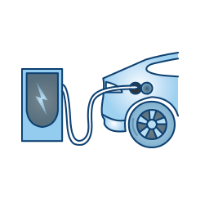
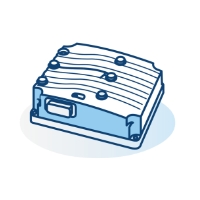

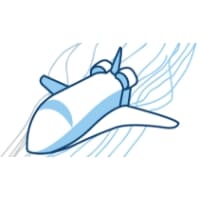

Skill-Lync offers industry relevant advanced engineering courses for engineering students by partnering with industry experts.
Our Company
4th Floor, BLOCK-B, Velachery - Tambaram Main Rd, Ram Nagar South, Madipakkam, Chennai, Tamil Nadu 600042.
Top Individual Courses
Top PG Programs
Skill-Lync Plus
Trending Blogs
© 2025 Skill-Lync Inc. All Rights Reserved.






